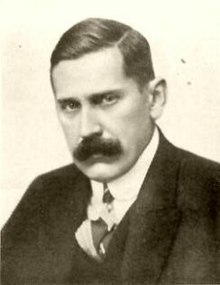Othenio Lothar Franz Anton Louis Abel(20 June 1875 – 4 July 1946) was anAustrianpaleontologistandevolutionary biologist.Together withLouis Dollo,he was the founder of "paleobiology"and studied the life and environment of fossilized organisms.[1]
Othenio Abel | |
|---|---|
 | |
| Born | 20 June 1875 |
| Died | 4 July 1946(aged 71) |
| Awards | Bigsby Medal(1911) Daniel Giraud Elliot Medal(1920) |
| Scientific career | |
| Fields | Paleontology |
Life
editAbel was born in Vienna, the son of the architect Lothar Abel. Abel earned a PhD, after studying both law and science, from theUniversity of Vienna.He remained there as an assistant toAlpinegeologistEduard Suess,before being appointed a professor of paleontology. Three years later, he finished hishabilitationthesis as a paleontologist at theUniversity of Vienna.From 1900 to 1907, he worked at the Geologische Reichsanstalt.
In 1907, Abel became an extraordinary professor in Vienna, and from 1917 to 1934 he was a regular professor of paleontology in Vienna. As such, he led several expeditions that gave him broad recognition, such as the Pikermi-expedition toGreecein 1912, anAmericanexpedition (1925) and one toSouth Africa(1929).
Abel became a member of theLeopoldinaacademy in 1935. From 1935 to 1940, he was a professor atGöttingen University,after which he was retired, age 61. In 1942, he was appointed an honorary member of thePaläontologische Gesellschaft.
Scientific activity
editAbel mainly studiedfossilvertebrates.He was a supporter ofNeo-Lamarckistevolution. His main contribution to the field, however, was the formulation, together withLouis Dollo,ofpaleobiology,which combines the methods and findings of thenatural sciencebiologywith the methods and findings of theearth sciencepaleontology.From 1928 onwards, Othenio Abel was the publisher of a journal dedicated topaleobiology,Paläobiologica.
In 1914, Abel proposed that fossildwarf elephantsinspired the myth of giantCyclopes,because the center nasal opening was thought to be a cyclopic eye socket.[2]In 1920 he was awarded theDaniel Giraud Elliot Medalfrom theNational Academy of Sciences.[3]He also showed great interest incave bearremains at the so-called "Dragon's Cave"nearMixnitz.
Abel was an advocate oforthogenesis,he believed that there were trends in evolution that were internally programmed.[4]
Political attitude and National Socialism
editAlready as a student, Abel took part inantisemiticriots at the University of Vienna, during theBadeni-crisis of 1897. After theFirst World War,now a professor, he gave voice to his fear of a power takeover by "Communists, Social Democrats and Jews and more Jews tied to both". As the journalist Klaus Taschwer publicized in 2012, Abel was responsible for the founding of a secret group of 18 professors that sought to frustrate the research and careers of left-wing and Jewish scientists.[5][6]The rise in violence ofNational Socialiststudent groups towards Jewish students in 1934 were met with sympathy by Abel. When such attacks began to be directed atCatholicand international students as well, Abel, now the universityrector,was forced into early retirement by theAustrofascistboard.[7]This caused him to emigrate to Germany and accept the post in Göttingen.
He visited Vienna again in 1939, after theAnschlusswithNazi Germany.After seeing how theNazi flagwas shown at the university building, he pronounced this the "Happiest moment of his life". The new regime honored him with the newly created post of "Honorary Senator" of the university - an honour that was rescinded after theSecond World War,in 1945. A letter of recommendation for theGoethe Prizepoints out how Abel had always "fought in the first line" against the "Judaification" of the university.[6][8][9]After the war, he was once again forced into retirement along with other prominent Nazi professors and spent his last days in Mondsee, then known as something of a "Nazi colony".
Selected writings
edit- Einige Monstrositäten bei Orchideenblüthen(1897)
- Ueber einige Ophrydeen(1898)
- Les dauphins longirostres du boldérien (miocène supérieur) des environs d'Anvers.Brussels 1901 - 1931doi:10.5962/bhl.title.16053
- Les odontocètes du Boldérien (miocène supérieur) d'Anvers.Brüssel 1905doi:10.5962/bhl.title.15923
- Fossile Flugfische(1906)
- "Neuere Anschauungen über den Bau und die Lebensweise der Dinosaurier."Berichte der Sektion für Paläozoologie16. Dezemb (1908): 117–22.
- Die Morphologie der Hüftbeinrudimente der Cetaceen.Vienna 1907doi:10.5962/bhl.title.16064
- "Die Rekonstruktion desDiplodocus."Abhandlungen der K.K. Zoologisch-botanischen Gesellschaft in Wien5 (1910).
- "Über die allgemeinen Prinzipien der paläontologischen Rekonstruktion." 'Verhandlungen der zoologisch-botanische Gesellschaft zu WienLX (1910): 141–46.
- "Die Vorfahren der Vögel und ihre Lebensweise."Verhandlungen der zoologisch-botanische Gesellschaft zu WienLXI (1911): 144–91.
- Grundzüge der Paläobiologie der Wirbeltiere.Stuttgart 1912doi:10.5962/bhl.title.61833
- Vorzeitliche Säugetiere.Jena 1914
- Die Tiere Der Vorwelt.Leipzig & Berlin 1914.
- Die Paläontologie in Forschung und Lehre.Naturwissenschaften3(1915), 413-19
- Paläobiologie der Cephalopoden aus der Gruppe der DibranchiatenJena 1916.doi:10.5962/bhl.title.46089
- Die Stämme der Wirbeltiere.Berlin, Leipzig, 1919doi:10.5962/bhl.title.2114
- Lehrbuch der Paläozoologie.Jena 1920
- Lebensbilder aus der Tierwelt der Vorzeit.Jena 1921doi:10.5962/bhl.title.61701
- Geschichte und Methode der Rekonstruktion vorzeitlicher Wirbeltiere.Jena 1925
- Paläobiologie und Stammesgeschichte ". Jena 1929
- Die Stellung des Menschen im Rahmen der Wirbeltiere.1931
- Vorzeitliche Lebensspuren.Jena 1935
- Die Tiere der Vorzeit in ihrem Lebensraum.Jena 1939
- Vorzeitliche Tierreste im Deutschen Mythus, Brauchtum und Volksglauben.Jena 1939
References
edit- ^Othenio AbelinAustria-Forum(in German)
- ^Adrienne Mayor,The First Fossil Hunters: Paleontology in Greek and Roman Times(Princeton University Press) 2000.
- ^"Daniel Giraud Elliot Medal".National Academy of Sciences.Retrieved16 February2011.
- ^Peter J. Bowler.(1996).Life's Splendid Drama: Evolutionary Biology and the Reconstruction of Life's Ancestry, 1860-1940.University Of Chicago Press. p. 358.ISBN978-0226069210
- ^"Hochburg des Antisemitismus",Der Standard,12. Juni 2012
- ^abKlaus Taschwer, "Othenio Abel, Kämpfer gegen die" Verjudung "der Universität",Der Standard,9. Oktober 2012
- ^Klaus Taschwer (2014),"Der Inkor-Rektor. Eine kurze politische Biografie des Paläontologen Othenio Abel (1875–1946)". Academia.edu(Accessed 29 January 2023).
- ^Ute Deichmann:Biologen unter Hitler,As cited in: Ernst Klee:Das Personenlexikon zum Dritten Reich.Wer war was vor und nach 1945, 2. Aufl., Frankfurt a.M. 2007, S. 9,ISBN978-3-596-16048-8.
- ^Taschwer, Klaus (2015). “Othenio Abel. Paläontologe, antisemitischer Fakultäts- und Universitätspolitiker,” InUniversität - Politik - Gesellschaft,edited by Mitchell G. Ash, andJosef Ehmer,287–92. Vienna University Press.
Further reading
edit- Baumgartel, Hans. "Abel, Othenio." inDictionary of Scientific Biography.(1970). New York: Charles Scribner's Sons. Vol. 1: p. 17-18.
- Ute Deichmann:Biologen unter Hitler. Porträt einer Wissenschaft im NS-Staat.Frankfurt: Fischer, 1995.ISBN3-593-34763-6
- Kurt Ehrenberg (1953),"Abel, Othenio Lothar Franz Anton Louis",Neue Deutsche Biographie(in German), vol. 1, Berlin: Duncker & Humblot, p. 13;(full text online)
- "Abel, Othenio."inTaxonomic Literature II Online.(n.d.). Smithsonian Institution Libraries.